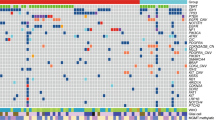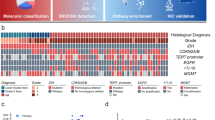Abstract
Identification of genetic copy number changes in glial tumors is of importance in the context of improved/refined diagnostic, prognostic procedures and therapeutic decision-making. In order to detect recurrent genomic copy number changes that might play a role in glioma pathogenesis and/or progression, we characterized 25 primary glioma cell lines including 15 non glioblastoma (non GBM) (I–III WHO grade) and 10 GBM (IV WHO grade), by array comparative genomic hybridization, using a DNA microarray comprising approx. 3500 BACs covering the entire genome with a 1 Mb resolution and additional 800 BACs covering chromosome 19 at tiling path resolution. Combined evaluation by single clone and whole chromosome analysis plus ‘moving average (MA) approach’ enabled us to confirm most of the genetic abnormalities previously identified to be associated with glioma progression, including +1q32, +7, −10, −22q, PTEN and p16 loss, and to disclose new small genomic regions, some correlating with grade malignancy. Grade I–III gliomas exclusively showed losses at 3p26 (53%), 4q13–21 (33%) and 7p15–p21 (26%), whereas only GBMs exhibited 4p16.1 losses (40%). Other recurrent imbalances, such as losses at 4p15, 5q22–q23, 6p23–25, 12p13 and gains at 11p11–q13, were shared by different glioma grades. Three intervals with peak of loss could be further refined for chromosome 10 by our MA approach. Data analysis of full-coverage chromosome 19 highlighted two main regions of copy number gain, never described before in gliomas, at 19p13.11 and 19q13.13–13.2. The well-known 19q13.3 loss of heterozygosity area in gliomas was not frequently affected in our cell lines. Genomic hotspot detection facilitated the identification of small intervals resulting in positional candidate genes such as PRDM2 (1p36.21), LRP1B (2q22.3), ADARB2 (10p15.3), BCCIP (10q26.2) and ING1 (13q34) for losses and ECT2 (3q26.3), MDK, DDB2, IG20 (11p11.2) for gains. These data increase our current knowledge about cryptic genetic changes in gliomas and may facilitate the further identification of novel genetic elements, which may provide us with molecular tools for the improved diagnostics and therapeutic decision-making in these tumors.
This is a preview of subscription content, access via your institution
Access options
Subscribe to this journal
Receive 50 print issues and online access
$259.00 per year
only $5.18 per issue
Buy this article
- Purchase on Springer Link
- Instant access to full article PDF
Prices may be subject to local taxes which are calculated during checkout



Similar content being viewed by others
References
Bakir A, Gezen F, Yildiz O, Ayhan A, Kahraman S, Kruse CA et al. (1998). Cancer Genet Cytogenet 103: 46–51.
Beghini A, Magnani I, Roversi G, Piepoli T, Di Terlizzi S, Moroni RF et al. (2003). Oncogene 22: 2581–2591.
Bigner SH, Mark J, Bigner DD . (1987). Cancer Genet Cytogenet 24: 163–176.
Bredel M, Bredel C, Juric D, Harsh GR, Vogel H, Recht LD et al. (2005). Cancer Res 10: 4088–4096.
Buschges R, Weber RG, Actor B, Lichter P, Collins VP, Reifenberger G . (1999). Brain Pathol 9: 435–442.
Cairncross JG, Ueki K, Zlatescu MC, Lisle DK, Finkelstein DM, Hammond RR et al. (1998). J Natl Cancer Inst 90: 1473–1479.
Chernova OB, Hunyadi A, Malaj E, Pan H, Crooks C, Roe B et al. (2001). Oncogene 20: 5378–5392.
Cleveland WS . (1979). J Am Stat Assoc 74: 829–836.
Collins VP . (2004). J Neurol Neurosurg Psychiatry 75 (Suppl 2): ii2–ii11.
Cowell JK, Barnett GH, Nowak NJ . (2004a). J Neuropathol Exp Neurol 63: 151–158.
Cowell JK, Matsui S, Wang YD, LaDuca J, Conroy J, McQuaid D et al. (2004b). Cancer Genet Cytogenet 151: 36–51.
Efimova EV, Al-Zoubi AM, Martinez O, Kaithamana S, Lu S, Arima T et al. (2004). Oncogene 23: 1076–1087.
Fischer H, Schwechheimer K, Heider M, Bernhardt S, Zang KD . (1985). Cancer Genet Cytogenet 17: 257–268.
Hackett CS, Hodgson JG, Law ME, Fridlyand J, Osoegawa K, de Jong PJ et al. (2003). Cancer Res 63: 5266–5273.
Harada K, Nishizaki T, Maekawa K, Kubota H, Harada K, Suzuki M et al. (2000). Genomics 67: 268–272.
Hartmann C, Johnk L, Kitange G, Wu Y, Ashworth LK, Jenkins RB, et al., Transcript Map of the 3.7-Mb D19S112–D19S246. (2002). Cancer Res 62: 4100–4108.
Hawkins CJ . (2004). Vitam Horm 67: 427–452.
Iafrate AJ, Feuk L, Rivera MN, Listewnik ML, Donahoe PK, Qi Y et al. (2004). Nat Genet 36: 949–951.
Ino Y, Betensky RA, Zlatescu MC, Sasaki H, Macdonald DR, Stemmer-Rachamimov AO et al. (2001). Clin Cancer Res 7: 839–845.
Jeuken JW, von Deimling A, Wesseling P . (2004). J Neurooncol 70: 161–181.
Kanno H, Shuin T, Kondo K, Yamamoto I, Ito S, Shinonaga M et al. (1997). Cancer Res 57: 1035–1038.
Kitange G, Misra A, Law M, Passe S, Kollmeyer TM, Maurer M et al. (2005). Genes Chromosomes Cancer 42: 68–77.
Kitange GJ, Templeton KL, Jenkins RB . (2003). Curr Opin Oncol 15: 197–203.
Kleihues P, Cavenee WK . (2000). Pathology and Genetics of Tumours of the Nervous System. IARC Press: Lyon, pp. 99–102.
Kohler B, Wolter M, Blaschke B, Reifenberger G . (2004). Int J Cancer 111: 644–645.
Koschny R, Koschny T, Froster UG, Krupp W, Zuber MA . (2002). Cancer Genet Cytogenet 135: 147–159.
Krzywinski M, Bosdet I, Smailus D, Chiu R, Mathewson C, Wye N et al. (2004). Nucleic Acids Res 32: 3651–3660.
Liu CX, Musco S, Lisitsina NM, Forgacs E, Minna JD, Lisitsyn NA . (2000). Cancer Res 60: 1961–1967.
Liu J, Yuan Y, Huan J, Shen Z . (2001). Oncogene 20: 336–345.
Magnani I, Chiariello E, Conti AM, Finocchiaro G . (1999). Cancer Genet Cytogenet 110: 82–86.
Magnani I, Guerneri S, Pollo B, Cirenei N, Colombo BM, Broggi G et al. (1994). Cancer Genet Cytogenet 75: 77–89.
Magnani I, Moroni RF, Roversi G, Beghini A, Pfundt R, Schoenmakers EFPM et al. (2005). Cancer Genet Cytogenet 161: 140–145.
Manni I, Tunici P, Cirenei N, Albarosa R, Colombo BM, Roz L et al. (2002). Br J Cancer 86: 477–484.
Marschang P, Brich J, Weeber EJ, Sweatt JD, Shelton JM, Richardson JA et al. (2004). Mol Cell Biol 24: 3782–3793.
Meng X, Liu J, Shen Z . (2003). Gene 302: 139–146.
Meng X, Liu J, Shen Z . (2004). Cell Cycle 3: 343–348.
Mischel PS, Cloughesy TF, Nelson SF . (2004). Nat Rev Neurosci 5: 782–792.
Mitelman F . (Ed). (1995). LSCN (1995): An International System for Human Cytogenetic Nomenclature. S. Karger: Basel.
Montpetit A, Boily G, Sinnett D . (2002). Eur J Hum Genet 10: 62–71.
Muraosa Y, Takahashi K, Yoshizawa M, Shibahara S . (1996). Eur J Biochem 235: 471–479.
Nigro JM, Misra A, Zhang L, Smirnov I, Colman H, Griffin C et al. (2005). Cancer Res 65: 1678–1686.
Noble M, Dietrich J . (2004). Trends Neurosci 27: 148–154.
Ohgaki H, Schauble B, zur Hausen A, von Ammon K, Kleihues P . (1995). Virchows Arch 427: 113–118.
Pandita A, Aldape KD, Zadeh G, Guha A, James CD . (2004). Genes Chromosomes Cancer 39: 29–36.
Perego P, Boiardi A, Carenini N, De Cesare M, Dolfini E, Giardini R et al. (1994). J Cancer Res Clin Oncol 120: 585–592.
Rey JA, Bello MJ, de Campos JM, Kusak ME, Moreno S . (1989). Cancer Genet Cytogenet 41: 175–183.
Riemenschneider MJ, Knobbe CB, Reifenberger G . (2003). Int J Cancer 104: 752–757.
Ritland SR, Ganju V, Jenkins RB . (1995). Genes Chromosomes Cancer 12: 277–282.
Rong Y, Post DE, Pieper RO, Durden DL, Van Meir EG, Brat DJ . (2005). Cancer Res 65: 1406–1413.
Schmidt MC, Antweiler S, Urban N, Mueller W, Kuklik A, Meyer-Puttlitz B et al. (2002). J Neuropathol Exp Neurol 61: 321–328.
Schraders M, Pfundt R, Straatman HM, Janssen IM, van Kessel AG, Schoenmakers EF et al. (2005). Blood 105: 1686–1693.
Sebat J, Lakshmi B, Troge J, Alexander J, Young J, Lundin P et al. (2004). Science 305: 525–528.
Shapiro J R . (2002). Am J Med Genet 115: 194–201.
Simpson JR, Horton J, Scott C, Curran WJ, Rubin P, Fischbach J et al. (1993). Int J Radiat Oncol Biol Phys 26: 239–244.
Smith JS, Alderete B, Minn Y, Borell TJ, Perry A, Mohapatra G et al. (1999). Oncogene 18: 4144–4152.
Sun CL, Chao CC . (2005). Mol Pharmacol 67: 1307–1314.
Tallen G, Kaiser I, Krabbe S, Lass U, Hartmann C, Henze G et al. (2004). Int J Cancer 109: 476–479.
Veltman JA, Jonkers Y, Nuijten I, Janssen I, van der Vliet W, Huys E et al. (2003a). Am J Hum Genet 72: 1578–1584.
Veltman JA, Fridlyand J, Pejavar S, Olshen AB, Korkola JE, DeVries S et al. (2003b). Cancer Res 63: 2872–2880.
Vissers LE, de Vries BB, Osoegawa K, Janssen IM, Feuth T, Choy CO et al. (2003). Am J Hum Genet 73: 1261–1270.
von Deimling A, Bender B, Jahnke R, Waha A, Kraus J, Albrecht S et al. (1994). Cancer Res 54: 1397–1401.
von Deimling A, Louis DN, von Ammon K, Petersen I, Wiestler OD, Seizinger BR . (1992). Cancer Res 52: 4277–4279.
Weber RG, Sabel M, Reifenberger J, Sommer C, Oberstrass J, Reifenberger G et al. (1996). Oncogene 13: 983–994.
Zhu Y, Parada LF . (2002). Nat Rev Cancer 2: 616–626.
Acknowledgements
This work was supported by AIRC (Associazione Italiana Ricerca sul Cancro) 2003 grant (to LL) and a Dutch Cancer Society grant (KWF-KUN 2004-3143) to a local research consortium including ES. We acknowledge the EC COST support through the COST ACTION B19 ‘Molecular cytogenetics of solid tumors’ short-term scientific mission (to GR) and collaboration thereafter primed in carrying out this work. We acknowledge Prof M Rocchi for providing us several BAC clones useful for FISH analyses.
Author information
Authors and Affiliations
Corresponding author
Additional information
Supplementary Information accompanies the paper on Oncogene website (http://www.nature.com/onc).
Supplementary information
Rights and permissions
About this article
Cite this article
Roversi, G., Pfundt, R., Moroni, R. et al. Identification of novel genomic markers related to progression to glioblastoma through genomic profiling of 25 primary glioma cell lines. Oncogene 25, 1571–1583 (2006). https://doi.org/10.1038/sj.onc.1209177
Received:
Revised:
Accepted:
Published:
Issue Date:
DOI: https://doi.org/10.1038/sj.onc.1209177
Keywords
This article is cited by
-
High Expression of BCCIP β Can Promote Proliferation of Esophageal Squamous Cell Carcinoma
Digestive Diseases and Sciences (2017)
-
Overexpression of NIMA-related kinase 2 is associated with poor prognoses in malignant glioma
Journal of Neuro-Oncology (2017)
-
Expression pattern of BCCIP in hepatocellular carcinoma is correlated with poor prognosis and enhanced cell proliferation
Tumor Biology (2016)
-
Fuse binding protein antagonizes the transcription activity of tumor suppressor protein p53
BMC Cancer (2014)
-
Silencing of KIF14 interferes with cell cycle progression and cytokinesis by blocking the p27Kip1 ubiquitination pathway in hepatocellular carcinoma
Experimental & Molecular Medicine (2014)



